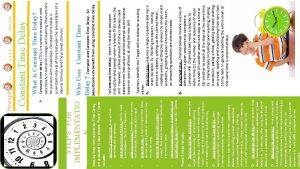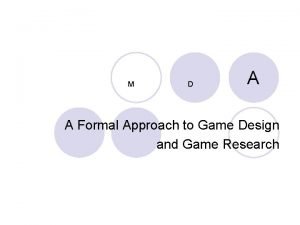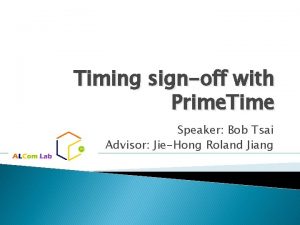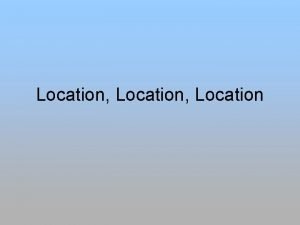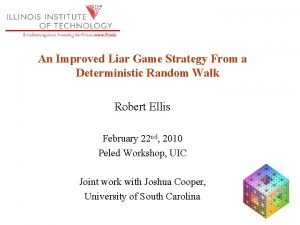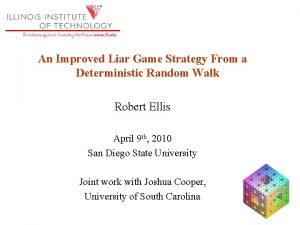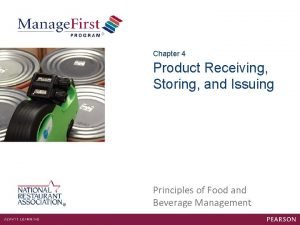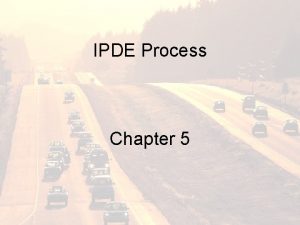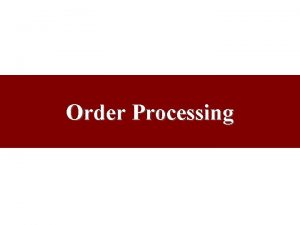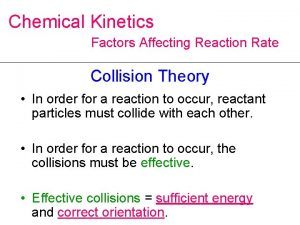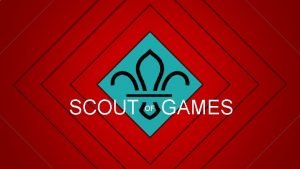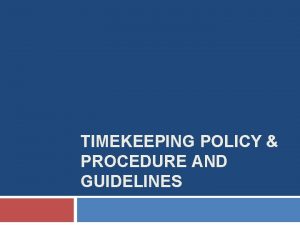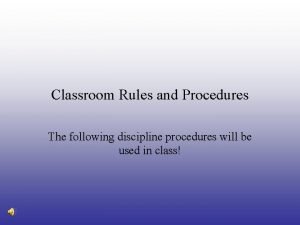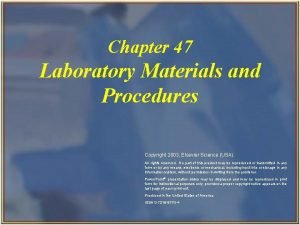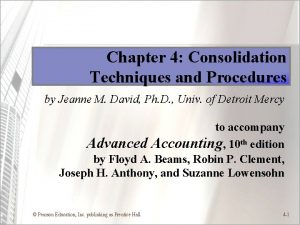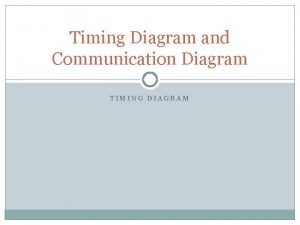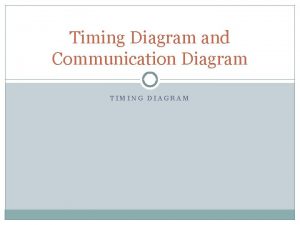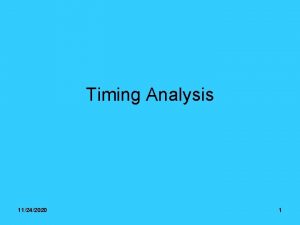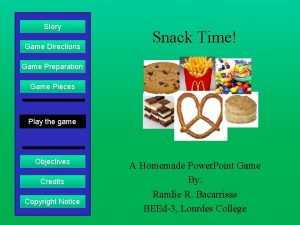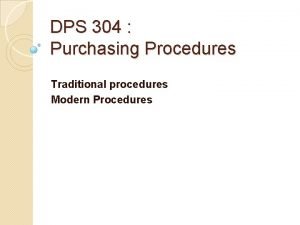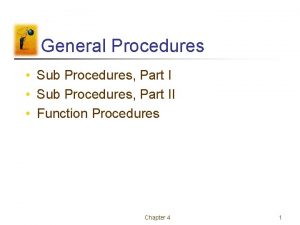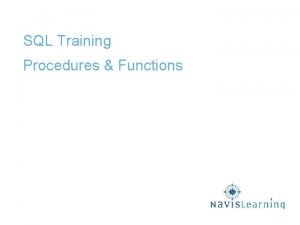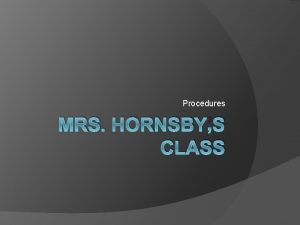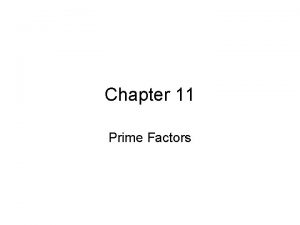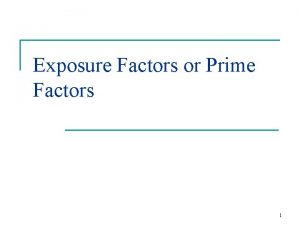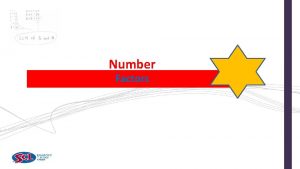GAME AND TIMING PROCEDURES TIMING AND TIME FACTORS






























- Slides: 30

GAME AND TIMING PROCEDURES

TIMING AND TIME FACTORS Playing Time 50 minutes, divided into two halves. Halftime 10 minutes; may be less if agreed upon by the coaches prior to the game. Players must change ends to begin the second half. Clock Stops • On official’s timeout signal • After each goal • On every whistle in the last two minutes of each half (unless there is a 10 -goal differential)

TIME OUTS Officials’ Time Outs • Taken in case of illness, accident, injury; for the issuance of a card; or unusual circumstances (e. g. , broken crosse, animal on field, etc. ) • No stick checks allowed during officials’ time outs. Team Time Outs • • Each team allowed two; they do not carry into overtime. Each team permitted one during the entire duration of overtime. Head coach or any player on the field may request a time out. Granted after a goal is scored or when requesting team has clear possession of the ball.

ACCIDENT, INTERFERENCE OR UNUSUAL CIRCUMSTANCES A Time-Out may be called at the discretion of the official due to: Accident Injury Interference Unusual Circumstances If a foul has occurred, the penalty will be administered. If no foul was involved, the ball is given to the player in possession of the ball or nearest to the ball when play was stopped. If two players are equidistant from the ball, Alternate Possession will be awarded.

SUSPENDED OR INTERRUPTED GAME A game is considered legal and complete when 80% of playing time has elapsed. Whether a game is interrupted and continues the same day OR a game is suspended and continues another day, the game restarts at the point of interruption. Suspended/Interrupted Game

SUSPENSION OF THE GAME - LIGHTNING Guidelines for Lightning Disturbances When thunder is heard or a cloud to ground lightning bolt is seen, the Each time thunder is heard storm is close enough to or lightning is seen, the strike your location with 30 -minute clock is reset. lightning. Suspend play and take shelter immediately! 30 -Minute Rule: Wait at least 30 minutes after the last thunder is heard or strike of lightning is seen before allowing teams back on the field. .

OVERTIME PROCEDURES § § Five-minute rest after regulation Coin toss (visiting captain calls) for choice of ends AP continues from regulation Winner decided by “Sudden Victory” Six-Minute Overtime Period Clock stops on every whistle. If no score, clock stopped at 3 minutes for teams to change ends. No delay for coaching. No substitutions at that time. Game restarts with draw. If no goal is scored, teams get a 3 -minute rest. **This procedure repeats until a winning goal is scored**

SUBSTITUTIONS • • • Players sub freely throughout the game during play or after a goal Subbing must take place in the Team Substitution Area (TSA) Players subbing in must wait until their teammate is completely in the TSA At the time a player is suspended or ejected, no sub will be allowed A sub may replace an injured player 10 yds.

ILLEGAL SUBSTITUTION ut itho w s er ent h the o h w ug ayer ing thro on area l p A go stituti sub A play er w injury ho enters du o timeo uts an r miscondu ring ct d is the in jured/ not replac ing su playe spended r eld the fi on r playe a r t x e An A player who enters prior to the teammate leaving the field A suspen d received ed player (havin g a secon d yellow ) r ot listed o A player n isted on the ly l incorrect he scorebook at in t roster or rt of the game s e th ta An ejected p layer (red ca rd) enter empts to ave t t a o h w icials h Player after off the game the draw. set Should an illegal substitution occur, the official will call a timeout and remove the illegal substitute and award the appropriate penalty.

SCORING A goal is scored when: • The whole ball passes completely over the goal line, between the goal posts • The ball has been shot with a legal crosse of attack players • The ball goes off the crosse or body of a defender • The ball is released from the crosse before time expires A goal is not scored when: • The ball is put through the goal by a non-player (official) • The ball comes off the body of an attacker • The attack player steps on or over the goal circle • A foul by the attack occurs on the shot (dangerous follow through, dangerous propel, goal circle violation, offsides, attacking team has an illegal player on the field) • The goal is scored with an illegal crosse • The ball enters the goal from the attacking team’s goalkeeper

STARTING AND RESTARTING PLAY Each half of the game, overtime period, and after each goal, the game is started with a draw. Any number of players up to 12 may be on the field at the start of each draw.

STARTING PLAY – THE DRAW O X O X Players taking the draw shall be in the center circle and toe the line O X All other players must be outside the restraining lines O X GK X O O X O X Two other teammates from each team may be between the restraining lines, but outside the center circle GK Goalies are not allowed between the restraining lines on a draw

FOR BOTH PLAYERS ON THE DRAW Pocket open to player’s Right side of crosse goalie is down

DRAW: BOTH RIGHT HAND Note: head position of both sticks

DRAW: ONE LEFT HAND, ONE RIGHT HAND Note: Body moved, but head position has not changed

PROPER SET UP?

DRAW RULES Activity: Set the Draw Crosses are held in the air, parallel to and above the center line Players taking the draw must remain motionless, except for head movement, until the whistle The first motion of the draw must be UP No players may step on or over the center circle until the whistle No players may step on or over the restraining line before the official signals "possession" Players may reach over the restraining line to play the ball, as long as the player's foot is NOT on or over the line

RESTARTING PLAY The whistle is used to stop and start play When starting play, the official will give a visual arm signal by raising the arm above the head Player fouled retains the ball Player who fouled is directed 4 m away (minor) or 4 m behind as directed All other players may move where they like as long as they are 4 m away

RESTARTING PLAY – FREE POSITIONS No FP may be taken closer than 4 m to a boundary line. 8 m No FP may be taken closer than 8 m to the goal circle. 4 m The violation of any rule is a foul. The penalty for a foul is a Free Position. Player committing the foul moves 4 m away/behind (depending on the foul. )

SELF-START O Settled Stance: Both feet stationary, on the ground, with the ball in the head of the crosse X

CRITERIA FOR SELF-START • Ball is outside of the CSA • Game clock is running • Ball is within 1 ½ stick’s length from the spot of the foul Ball more than 1 ½ stick’s length away? • Offensive player initiating self-start may pick up the ball, bring it back to the spot of foul and self-start. • Teammate may also pick up ball and return it to the ball carrier so that she may self-start from a legal position.

SELF-START – FOULED PLAYER Fouled Player options: 1. Restart play immediately 2. Wait for other players to move 4 m away 3. Wait for whistle Play will commence once the ball carrier steps or passes Repeatedly self-starting beyond playing distance (1 ½ stick’s length away) may result in a warning and/or Delay of Game penalty. Note: Proactive officiating may prevent need for whistle!

SELF-START – DEFENSIVE TEAM After the foul is called, offender must initiate movement 4 m behind or away, as directed by official. Defenders may not engage ball carrier until play has commenced. These motions do NOT commence play: Pivoting or rocking motions Cradling the ball Pumping the crosse Repeated failure to move away from the free position or move behind the ball carrier may result in a warning and/or Delay of Game penalty.

WHEN IS SELF-START NOT AN OPTION? Ø Ø Ø When the game clock is stopped Restraining Line violation (offsides) Fouls in the Critical Scoring Area (defensive or offensive) Alternate Possession Inadvertent Whistle A goal is scored The foul for self-start when it is not allowed is a False Start. Note: Proactive officiating may prevent false starts!

ALTERNATE POSSESSION Ball goes into the goal off a non-player The ball goes out of bounds as the result of a shot or deflected shot and two opposing players are equally near the ball It cannot be determined which team caused the ball to go out of bounds The ball lodges in the clothing of a field player or official Off-setting fouls occur Play is stopped, no player had possession and opposing players are equidistant from the ball The first AP of the game is determined at the captain’s meeting CSA e h w n t AP i or belo d ve de (abo is awar st ) GLE e neare at th OT! D

BOUNDARY SELF-STARTS 2 m Team awarded possession may run onto the field with the ball to restart play. O X X Play may not start with a pass from out of bounds!

BOUNDARY SELF-STARTS WITH FOUL 4 m O X If the ball goes out of bounds as the result of a foul, fouled player is positioned, with the ball, at the spot of the foul, 4 m from the boundary.

The ball is out of bounds when: ü A player steps on or over the boundary line ü Her body or crosse touches the ground on or outside the line ü A loose ball touches the ground on or outside the line BOUNDARIES The team that last touches the ball loses possession On a shot or deflected shot, the player/crosse closest to the BALL will be awarded possession Play is restarted when the player awarded the ball runs onto the field with the ball

BOUNDARY BALL AFTER SHOT Body/crosse closest when and where ball crosses line determines possession!

Believe you can and you're halfway there. Theodore Roosevelt
 What is elapsed time
What is elapsed time Time delay procedures
Time delay procedures Is wood abiotic or biotic
Is wood abiotic or biotic Abiotic vs biotic factors
Abiotic vs biotic factors Abiotic factors and biotic factors
Abiotic factors and biotic factors Common factors of 16 and 14
Common factors of 16 and 14 7-1 factors and greatest common factors
7-1 factors and greatest common factors Factors of 8 and 24
Factors of 8 and 24 A formal approach to game design and game research
A formal approach to game design and game research Prime time timing
Prime time timing Site vs situation factors
Site vs situation factors Is tulip biotic or abiotic
Is tulip biotic or abiotic Site vs situation
Site vs situation Pirate game theory
Pirate game theory Rules for the farming game
Rules for the farming game Game lab game theory
Game lab game theory Liar game game theory
Liar game game theory Liar game game theory
Liar game game theory Recruitment selection and induction process
Recruitment selection and induction process Receiving and storing
Receiving and storing Ipde stands for:
Ipde stands for: Importance of order cycle
Importance of order cycle Factors that affect reaction time
Factors that affect reaction time Factors that affect reaction time
Factors that affect reaction time Scentsy game
Scentsy game House of games rhyme time questions
House of games rhyme time questions Real time strategy game
Real time strategy game Timekeeping policy examples
Timekeeping policy examples Classroom policies and procedures
Classroom policies and procedures Chapter 47 laboratory materials and procedures
Chapter 47 laboratory materials and procedures Consolidation techniques and procedures
Consolidation techniques and procedures

